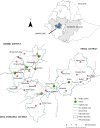Uncovering spatial variation in maternal healthcare service use at subnational level in Jimma Zone, Ethiopia
- PMID: 32736622
- PMCID: PMC7394677
- DOI: 10.1186/s12913-020-05572-0
Uncovering spatial variation in maternal healthcare service use at subnational level in Jimma Zone, Ethiopia
Abstract
Background: Analysis of disaggregated national data suggest uneven access to essential maternal healthcare services within countries. This is of concern as it hinders equitable progress in health outcomes. Mounting an effective response requires identification of subnational areas that may be lagging behind. This paper aims to explore spatial variation in maternal healthcare service use at health centre catchment, village and household levels. Spatial correlations of service use with household wealth and women's education levels were also assessed.
Methods: Using survey data from 3758 households enrolled in a cluster randomized trial geographical variation in the use of maternity waiting homes (MWH), antenatal care (ANC), delivery care and postnatal care (PNC) was investigated in three districts in Jimma Zone. Correlations of service use with education and wealth levels were also explored among 24 health centre catchment areas using choropleth maps. Global spatial autocorrelation was assessed using Moran's I. Cluster analyses were performed at village and household levels using Getis Ord Gi* and Kulldorf spatial scan statistics to identify cluster locations.
Results: Significant global spatial autocorrelation was present in ANC use (Moran's I = 0.15, p value = 0.025), delivery care (Moran's I = 0.17, p value = 0.01) and PNC use (Moran's I = 0.31, p value < 0.01), but not MWH use (Moran's I = -0.005, p value = 0.94) suggesting clustering of villages with similarly high (hot spots) and/or low (cold spots) service use. Hot spots were detected in health centre catchments in Gomma district while Kersa district had cold spots. High poverty or low education catchments generally had low levels of service use, but there were exceptions. At village level, hot and cold spots were detected for ANC, delivery care and PNC use. Household-level analyses revealed a primary cluster of elevated MWH-use not detected previously. Further investigation of spatial heterogeneity is warranted.
Conclusions: Sub-national variation in maternal healthcare services exists in Jimma Zone. There was relatively higher poverty and lower education in areas where service use cold spots were identified. Re-directing resources to vulnerable sub-groups and locations lagging behind will be necessary to ensure equitable progress in maternal health.
Keywords: Clusters; Equity; Ethiopia; Maternal health service use; Spatial analysis; Sub-national data.
Conflict of interest statement
The authors declare that they have no competing interests.
Figures






Similar articles
-
Spatial pattern of perinatal mortality and its determinants in Ethiopia: Data from Ethiopian Demographic and Health Survey 2016.PLoS One. 2020 Nov 23;15(11):e0242499. doi: 10.1371/journal.pone.0242499. eCollection 2020. PLoS One. 2020. PMID: 33227021 Free PMC article.
-
Spatial variations and determinants of optimal antenatal care service utilisation in Ethiopia: spatial and survey regression analysis.Public Health. 2023 Jul;220:18-26. doi: 10.1016/j.puhe.2023.04.010. Epub 2023 May 23. Public Health. 2023. PMID: 37229944
-
Spatial distribution of common childhood illnesses, healthcare utilisation and associated factors in Ethiopia: Evidence from 2016 Ethiopian Demographic and Health Survey.PLoS One. 2023 Mar 10;18(3):e0281606. doi: 10.1371/journal.pone.0281606. eCollection 2023. PLoS One. 2023. PMID: 36897920 Free PMC article.
-
The effect of antenatal care on use of institutional delivery service and postnatal care in Ethiopia: a systematic review and meta-analysis.BMC Health Serv Res. 2018 Jul 24;18(1):577. doi: 10.1186/s12913-018-3370-9. BMC Health Serv Res. 2018. PMID: 30041655 Free PMC article.
-
Cost of Utilising Maternal Health Services in Low- and Middle-Income Countries: A Systematic Review.Int J Health Policy Manag. 2021 Sep 1;10(9):564-577. doi: 10.34172/ijhpm.2020.104. Int J Health Policy Manag. 2021. PMID: 32610819 Free PMC article.
Cited by
-
Identifying geographical inequalities of maternal care utilization in Ethiopia: a Spatio-temporal analysis from 2005 to 2019.BMC Health Serv Res. 2022 Nov 30;22(1):1455. doi: 10.1186/s12913-022-08850-1. BMC Health Serv Res. 2022. PMID: 36451235 Free PMC article.
-
Assessment of mothers' satisfaction towards child vaccination service in South Omo zone, South Ethiopia region: a survey on clients' perspective.BMC Womens Health. 2024 May 9;24(1):272. doi: 10.1186/s12905-024-03120-0. BMC Womens Health. 2024. PMID: 38724930 Free PMC article.
-
Utilisation and associated socio-demographic factors related to the maternal continuum of care in sub-Saharan Africa: A systematic review and meta-analysis.J Glob Health. 2024 Oct 18;14:04180. doi: 10.7189/jogh.14.04180. J Glob Health. 2024. PMID: 39422108 Free PMC article.
-
How applicable is geospatial analysis in maternal and neonatal health in sub-Saharan Africa? A systematic review.J Glob Health. 2022 Aug 9;12:04066. doi: 10.7189/jogh.12.04066. J Glob Health. 2022. PMID: 35939400 Free PMC article.
-
Geographical variation and predictors of zero utilization for a standard maternal continuum of care among women in Ethiopia: a spatial and geographically weighted regression analysis.BMC Pregnancy Childbirth. 2022 Jan 28;22(1):76. doi: 10.1186/s12884-021-04364-6. BMC Pregnancy Childbirth. 2022. PMID: 35090405 Free PMC article.
References
-
- Central Statistical Agency (CSA) [Ethiopia] and ICF. 2016. Ethiopia Demographic and Health Survey 2016. Addis Ababa, Ethiopia, and Rockville, Maryland, USA: CSA and ICF. https://dhsprogram.com/publications/publication-FR328-DHS-Final-Reports.cfm.
MeSH terms
Grants and funding
LinkOut - more resources
Full Text Sources
Medical

